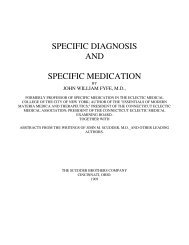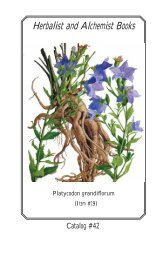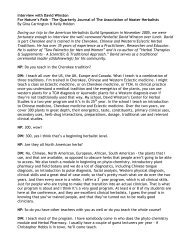MEDlCINAL PLANTS OF JAMAICA. PARTS 1 & 11.
MEDlCINAL PLANTS OF JAMAICA. PARTS 1 & 11.
MEDlCINAL PLANTS OF JAMAICA. PARTS 1 & 11.
You also want an ePaper? Increase the reach of your titles
YUMPU automatically turns print PDFs into web optimized ePapers that Google loves.
TAMARINDUS INDICA L. Tamarind.<br />
The leaves of tamarind are used in Jamaica as an ingredient of baths for fever and pains. In Cuba a root<br />
decoction is employed in the treatment of haemorrhages and "enfermedades del hidago" (liver disorders). (3, 5.<br />
7, 8, 9, 10, 11, 14, IS, 16, 17, 22, 23, 25, 27, 37, 39, 47, 50, 62).<br />
CAMPANULACEAE<br />
A family of about fifteen hundred widely distributed. mostly herbaceous, plants with lactiferous<br />
elements. On the whole the family is of little chemical importance though alkaloids such as lobelin and isotomin<br />
occur in some species.<br />
ISOTOMA LONGIFLORA (L) Presl. Madam Fate: Star Flower; Horse Poison.<br />
In Jamaica this plant appears to have a reputation not unconnected with magic. "When looking for it do<br />
not call its name or you will not find it" and again "It will keep away harm-anything that threatens you". Soaked<br />
in white rum it is commonly used as a lotion for pains and a little may be drunk. Despite its poisonous nature-it<br />
is said to contain an amorphous tonic alkaloid called isotomin-it is also sometimes used to make tea for colds.<br />
Beckwith said it was boiled with "tall Bahama grass" and "Apimpe" for a bath. (2, 9, 14, 27, 28).<br />
CANNABINACEAE<br />
A family containing only two genera-Humulus and Cannabis. The plants are aromatic and bear<br />
glandular hairs.<br />
CANNABIS SATIVA L. Gania: Indian hemp.<br />
Cannabis sativa, which is a source of hemp and bird seed, produces also the ganja, hashish or bhang, and<br />
the charas or churrus of commerce. The latter is the crude resin, ganja consists of the short-stemmed female<br />
tope, while bhang is made up of the larger leaves and stems of both male and female plants. The use of hemp<br />
for its intoxicating and medical pro perties is widespread in the Orient. Africa and Middle East and dates back<br />
to very early times. Its antispasmodic and anodyne properties have been employed in Western medicine in the<br />
treatment of neuralgia. asthma. tetanus and mania cases but it is now chiefly notorious for the deleterious effects<br />
produced on those who become addicted to the drug. Its use in the treatment of asthma is known and practised<br />
in Jamaica where the dried herb is infused in hot water to make tea. This may also be used in cases of fever and<br />
colds. In Southern Rhodesia the plant is used by the native population in cases of malaria, anthrax, blackwater<br />
fever, blood poisoning and child-birth. The resin is said to contain several active constituents including cannabinol.<br />
cannabidiol. cannin. cannabol. Also present are a volatile oil containing terpenes and a sesquiterpene,<br />
cholin, and trigonelline. According to some authorities the male and female plants differ in composition and it<br />
has also been claimed that hemp grown in temperate climates differs in composition from that grown in the<br />
tropics. Ganja has been included in the pharmacopoeias of Britain, United States of America and India. (3, 10.<br />
17. l8. 23. 26. 27. 39. 61).<br />
CANELLACEAE<br />
The family comprises a few woody tropical species with aromatic bark. Essential oils,<br />
mannitol. galactan, xylan and araban occur.<br />
CANELLA WINTERANA Gaertin. (= G. alba Sw.) Wild Cinnamon: White Cinnamon; Whitewood<br />
Bark; Canella; False Winter's Bark.<br />
The bark of Canella winterana is commonly sold in the markets of Jamaica and, soaked in rum. it<br />
provides a favourite embrocation for pains. A little of the liquid may be drunk in cases of stomach pains. It has<br />
been known in Europe as a spice since the seventeenth century and was used as aromatic bitter and stimulant. It<br />
is an ingredient of Riera Picra. The drug Canella was at one time included in the pharmacopoeias. It has been<br />
used in the treatment of dyspepsia. dysentery. rheumatism. gout and syphilis and in the West Indies had some<br />
reputation as a cephalic( in the form of snuff) and antiscorbutic. Canella contains 0.75 to 1.25% volatile oil with<br />
loa-pinene, eugenol, cineole. caryophyllene; about 8 % resin and 8 % mannitol.







